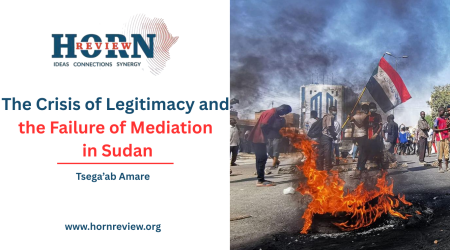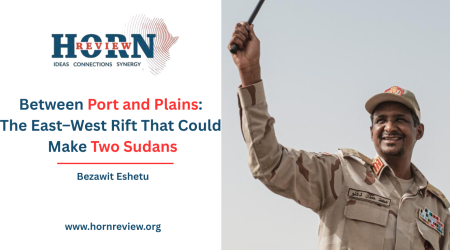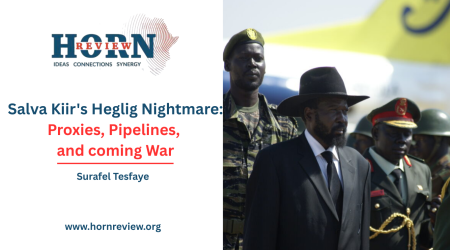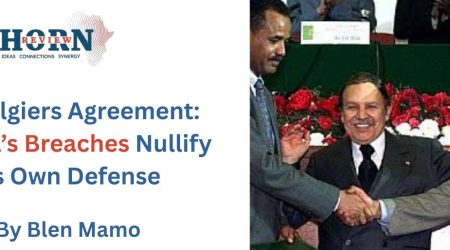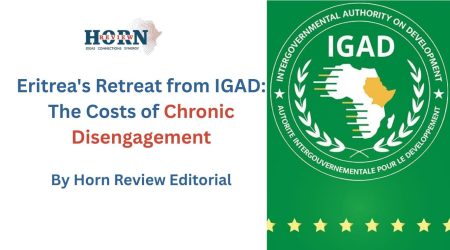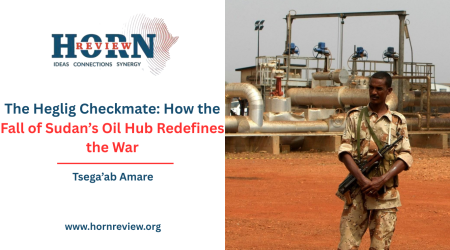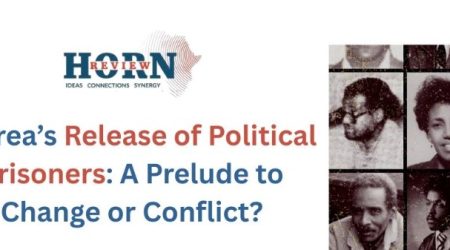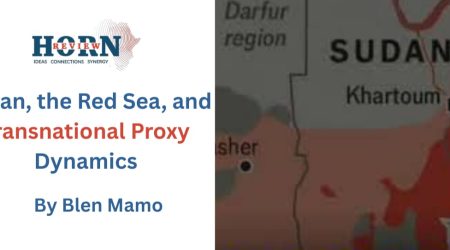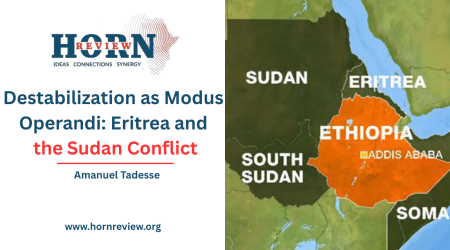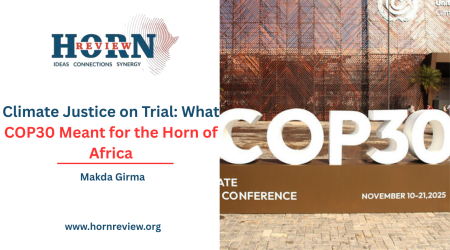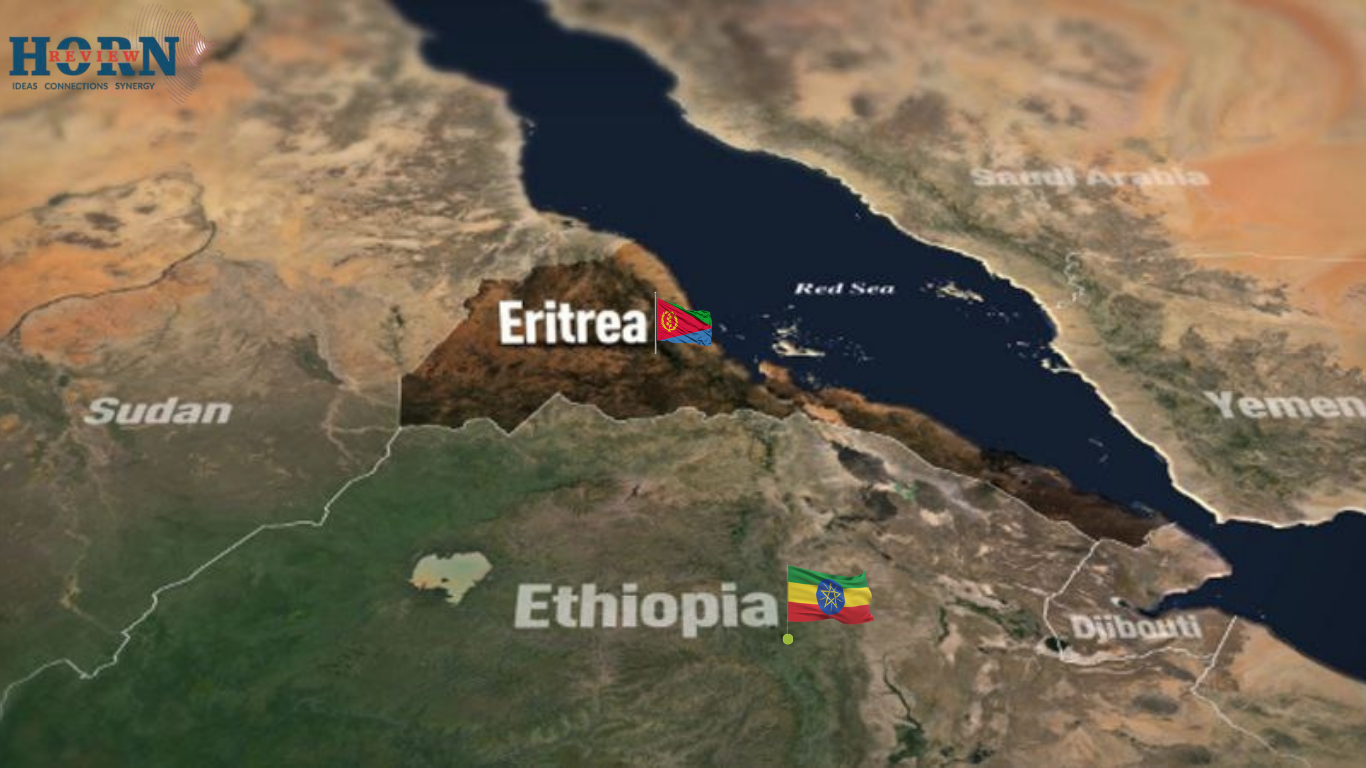
25
Jul
Transcending the Ethio-Eritrean Conundrum: A Vision for a Better Tomorrow
An Exclusive Horn Review Special
By Ambassador Dina Mufti
The European Inspiration
In his remarks delivered when the EU received the Nobel Peace Prize, Herman Van Rompuy, President of the European Council, had this to say about how Germany and France transcended generations of animosity to bring about enduring peace in Europe;
“To think of what France and Germany had gone through …, and then take this step … Signing a Treaty of Friendship … Each time I hear these words – Freundschaft, Amitié –, I am moved. They are private words, not for treaties between nations. But the will to not let history repeat itself, to do something radically new, was so strong that new words had to be found.”
This courage to “do something radically new” was necessary to not repeat the cycle of violence and vengeance that had engulfed the European continent. The vision of figures like Jean Monnet and Robert Schuman was critical in transforming the conflict between Germany and France. Had these important figures approached the challenging question of how to secure peace in post-World War II Europe in the same manner that France has approached the issue in the aftermath of the First World War, the outcome probably would have been a similar descent into another round of hostilities. Fortunately, the bold vision of these towering figures to bring together nations that have waged war against one another for so long has yielded peace and prosperity not just for Germany and France but for the whole of Europe. The journey of the European Union is a difficult, still inspiring for countries in the Horn of Africa, particularly Ethiopia and Eritrea, should emulate.
A Look Back at History
In modern times, there have been so many wars in the Ethiopia-Eritrean theater that it is very difficult to keep track. Due to the strategic significance of the Eritrean coastline, Ottomans, Egyptians, Italians, the British, and the Americans have at one time or another had a presence along this coastline, and some have even tried to control it by force. This has resulted in conflicts with the local population and rulers. Most consequential was the Italian occupation of Eritrea, which has lasted for more than half a century and contributed to the rise of a distinct Eritrean identity. After the Italians left in 1941, they were replaced by the British, who ruled Eritrea initially as an occupied enemy territory and later on as a UN Protectorate. In 1952, the British mandate came to an end, and Eritrea was federated with Ethiopia based on a UN General Assembly resolution. The federation was a compromise between the competing demands for autonomy and unity, which were two sentiments widely reflected among the Eritrean public, as ascertained by a UN Commission tasked with providing a recommendation on Eritrea’s future. Based on the recommendation of this commission which included representatives from Burma, Guatemala, Norway, Pakistan, and South Africa, Eritrea was federated with Ethiopia and had its internal government structure, including its representative assembly.
However, Eritrea’s democratic constitution and self-government were at odds with the Ethiopian empire’s absolute monarchy. This anomalous reality could have been resolved by democratizing the rest of the Ethiopian state. However, Emperor Haile Selassie opted to resolve this incongruity by orchestrating the dissolution of the Eritrean self-administration and turning Eritrea into just another province within his empire. Thus, just ten years after its formation, the federation came to an end. This was a blow to many pro-Ethiopia Eritreans who have advocated for unity with Ethiopia under a federal arrangement. The loss of the constitutional rights and democratic institutions that Eritreans have come to enjoy in the federal arrangement prescribed by the UN angered even those whose sentiments were inclined towards union with Ethiopia. This development emboldened those who had from the very beginning advocated for the formation of an independent Eritrean state. With the support of countries in the region who, for their geopolitical considerations, support the secession of Eritrea, the nascent independence movement gained strength and became a formidable insurgency. When Emperor Haile Selassie was deposed in a coup, the titular military head of state who replaced him was an Eritrean General called Aman Andom. General Aman tried to pursue a negotiated solution to end the Eritrean insurgency and secession movement. However, his peace overtures were viewed as treasonous by hardliner elements within the provisional military administration. The hardliners used this as an excuse to execute General Aman and launched a brutal military campaign against Eritrean insurgents. The brutality of the campaign and the inept political messaging that accompanied it fueled the separatist movement. President Mengistu, who emerged as the ultimate leader of the Provisional Military Administration, was initially reluctant to engage in negotiations to find a political solution to the conflict. By the time he expressed readiness to negotiate, it was too late. His government was toppled by a consortium of rebels, chief among which was the Eritrean People’s Liberation Front (EPLF), colloquially known as Shabia. Not only has the EPLF kicked the central government completely out of Eritrea, but it managed to partner with various ethnic rebel groups to take over the whole of Ethiopia. A key partner of the EPLF in this endeavor was the Tigray Peoples Liberation Front (the TPLF).
The Complex History of TPLF and EPLF
The two liberation fronts have a very complex and long history together. In addition to ethnic and linguistic commonalities, both fronts fought side by side against the central government. The founders of the TPLF received critical support, including training and arms, from the EPLF at the inception of their armed struggle. On the other hand, the TPLF provided the support that enabled EPLF to survive the Red Star campaign launched by the central government, which nearly vanquished the EPLF. Therefore, both organizations could claim that one would not be in existence had it not been for the support of the other. However, their relationship has not always been friendly and symbiotic. EPLF, which is a much older organization, considers itself to be more sophisticated, organized, and superior to the TPLF. This superiority complex of the EPLF mirrors the broad attitude of Eritreans towards their southern cousins. On the other hand, the EPLF was viewed by many within the TPLF as being undemocratic and lacking in progressive credentials. Despite their occasional squabbles, both organizations were able to fight side by side and effectively dismantle the central government led by Colonel Mengistu Hailemariam. Mengistu Hailemariam, who relied heavily on the military, technical, and financial support of the former USSR, could not resist the rebels once the USSR collapsed. Therefore, in 1991, he fled to Zimbabwe leaving the Ethiopian state in shambles. After the demise of Mengistu’s dictatorship, the EPLF and the TPLF parted ways, with the EPLF forming an independent Eritrean state through a secession formalized by a referendum. The TPLF formed a government in Addis Ababa, assuming the task of reorganizing and rebuilding the Ethiopian state. The new governments in Addis Ababa and Asmara, former comrades in arms, had friendly relations in the early 1990s. The TPLF-led government in Addis Ababa wholeheartedly facilitated the Eritrean secession and was the first to formally recognize Eritrea as an independent state. Meles Zenawi, the new ruler of Ethiopia, was an articulate and passionate champion of Eritrean independence. This was demonstrated in his address during a ceremony held in Eritrea to celebrate Eritrean independence. Meles addressed the crowd in Tigrigna, which is his mother tongue and a language widely spoken both in northern Ethiopia and in Eritrea. In the early 1990s, the rapport and bond of history that existed between TPLF and EPLF were very exceptional and seemed quite strong. But this era of friendship did not last even a decade. War broke out between Ethiopia and Eritrea in 1998.
The Ethiopia-Eritrean War of 1998-2000 and Its Aftermath
Although the border town of Badme was casus belli, everyone who followed the relationship of the two countries knew better than to assume that the war was really about the border. The real reason for the war was the shifting power dynamics between TPLF and EPLF. TPLF, having assumed control of the bigger and more populous Ethiopian state, was not willing to play the role of the junior partner to the EPLF anymore. Especially, some within the senior TPLF leadership who had always felt slighted by the superiority complex of the EPLF wanted to adopt a more assertive posture towards Eritrea. In the aftermath of Eritrean independence, there was not a serious effort to formalize and regulate the economic relationship between the two countries. Eritreans continued to operate within the Ethiopian economy as if Eritrean independence had not happened. The two countries used the same currency, and their economy functioned as if they had a single market and customs union, although no such arrangement was formally put in place.
On the other hand, immediately after Eritrean independence, Ethiopians were evicted en masse from Eritrea. Most of these Ethiopians were from the Tigray region, which was the constituency of the TPLF. The lopsided economic relationship was perceived as enabling the extraction of Ethiopian resources by a predatory Eritrean state. To put an end to this, the Government in Addis Ababa introduced a new currency, and the regional administration in Tigray also started enforcing customs and border controls. The Eritrean government was not pleased with this development and wanted to maintain the status quo as far as the economic relationship between the two countries was concerned. This relationship privileged Eritrean economic interest and was beneficial to the newly independent Eritrea. The business model adopted by government-affiliated Eritrean businesses was a lucrative one in which they buy Ethiopian commodities in Ethiopian currency and export these products internationally, earning much-needed hard currency to finance Eritrean industrialization. The output of Eritrean factories would then be sold in the vast Ethiopian market without any trade barrier or hindrance. However, Ethiopian businesses did not have a similar privilege in Eritrea.
While the TPLF leadership initially had to tolerate this anomalous relationship in the first few years of its incumbency, the longer they stayed in power and the more confident they became in their role as rulers of the Ethiopian state, senior TPLF figures started pushing back against this arrangement. President Isayas of Eritrea was certain that, given the superior military capabilities of Eritrea then, he would be able to impose any arrangement that he saw fit on Ethiopia. This was a huge miscalculation. Although the TPLF was not at first prepared to withstand the Eritrean military onslaught, within a few months, the TPLF was able to mobilize the Ethiopian public and field a huge army to fend off Eritrean troops from northern Ethiopia. This occasion also offered an opportunity to the TPLF and its coalition of ethnic parties to present themselves as a pan-Ethiopian political entity defending the sovereignty, and territorial integrity of Ethiopia. Ultimately, the Ethiopian government led by the TPLF prevailed in the two-year conflict and was able to dislodge the Eritrean army from all the border areas that it occupied.
In the aftermath of the war, there was a split within the TPLF. The split revolved around whether or not the Ethiopian army should have gone all the way to Asmara to bring about a regime change. Some advocated that the Ethiopian army should retake the Assab port. But Prime Minister Meles Zenawi, who opposed the more adventurous proposals of his colleagues within the TPLF, won the day and purged his rivals from the party. Despite the restraint Prime Minister Meles showed by not heeding the popular demand to let the Ethiopian army take the war to Asmara, President Isayas was not one to show any gratitude. For the next twenty years, Eritrea continued arming and training all sorts of rebel groups and even jihadists in Somalia with the hope of destabilizing the Ethiopian state. These activities resulted in Eritrea’s international isolation and its subjection to UN sanctions. Eritrea continued in a war footing, forcing soldiers in its conscript army to provide indefinite military service. The whole state and society were completely militarized. Veteran EPLF figures who questioned the wisdom of such policies and who called for democratic reforms in the aftermath of the war were arrested without any charges or trial. These senior political figures are still believed to be in captivity and not even their families are sure if they are alive or dead. The aftermath of the war resulted in purges and political turmoil both in Ethiopia and Eritrea. But these effects were long-lasting in Eritrea. A Bunker mentality and the absolute dictatorship of President Isayas reduced Eritrea into a garrison state with a sizeable portion of its population fleeing the country, turning Eritrea into one of the biggest sources of refugees and asylum seekers globally. The dream of Eritrean liberation turned into a nightmare of servitude.
The Rapprochement and the Discordant Note
The standoff between Eritrea and Ethiopia in the aftermath of the 1998-2000 war lasted for 18 years. Meles Zenawi, who was once a friend, then an archnemesis of President Isayas died while in office in 2012. Meles was succeeded by Prime Minister Hailemariam Desalegn, during whose six years tenure things stayed pretty much as they were on the Eritrean front. However, when Hailemariam Desalegn stepped down and Abiy Ahmed assumed the premiership in Addis Ababa, a dramatic shift occurred. Prime Minister Abiy, in his inaugural address to parliament as the Prime Minister of Ethiopia, on his very first day in office, proclaimed his intention to make peace with Eritrea. This message sent shockwaves throughout the Horn of Africa. Eager to emerge out of the isolation and opprobrium in which he was wallowing, President Isayas quickly accepted the call for peace issued by the new Ethiopian Prime Minister. At a dizzying speed, things that seemed impossible to imagine just a few months ago occurred in quick succession. Direct flights resumed between the two capitals, and direct telecom connection was made possible. Families separated for two decades were united. The Prime Minister of Ethiopia received a rockstar reception from the public in Asmara, and the Eritrean President received a rapturous welcome in Addis Ababa. The Ethiopian Prime Minister received a Nobel Peace Prize for his peace initiative.
However, during the honeymoon of the Ethiopia-Eritrea rapprochement, there was a discordant note coming from Mekelle, the regional capital of the Tigray region. Abiy’s rise to the premiership in Addis Ababa was not a smooth affair. The TPLF bosses and veterans who had become even more dominant and fractious after the death of Meles Zenawi did not want Abiy as Prime Minister. In Hailemariam, they had a compliant premier who did their bidding more often than not. They knew that Abiy was cut from a different cloth. So, they bitterly opposed his election as the chairperson of the EPRDF, the consortium of ethnic parties founded by the TPLF. Despite their opposition, Abiy outmaneuvered them and became chairperson of the party and Prime Minister of the Federal Government. Consolidating his hold on power, he also merged eight ethnic and regional parties into one pan-Ethiopian political party.
Disgruntled and aggrieved by the rise of the new Prime Minister, who soon started to assert his power as head of government, the TPLF bosses decamped to Mekelle. Most consequential would be the former spy boss. The powerful security chief, Getachew Assefa, who had served as head of the National Intelligence and Security Services for almost two decades, had attempted to forestall the rise of Abiy. A few months after Abiy was sworn in, Getachew was dismissed from his post and did not waste any time before he took off to Mekelle. Publicly lambasted for human rights violations and other abuses of power, Getachew Assefa and other TPLF veterans assembled in Mekelle and started to plot Abiy’s downfall and their comeback to power. Given the TPLF’s overwhelming dominance in Ethiopia’s security machinery, Getachew Assefa and company were confident that they could make Abiy’s rule short and turbulent. Getachew’s operatives directly and indirectly instigated communal clashes along ethnic and religious lines across Ethiopia. They engaged in economic sabotage measures and media campaigns to discredit the new government. Underestimating Abiy’s staying power, the TPLF, under the shadow leadership of Getachew and with the support of the TPLF elite who felt marginalized by the new Prime Minister, conducted an intense campaign to delegitimize and topple Abiy. When this campaign failed, the TPLF leadership resorted to an actual military campaign intending to dislodge Abiy’s Prosperity Party from power. Bereft of experienced military commanders who were veterans of the TPLF insurgency days, the TPLF strategists did not think that the Ethiopian National Defense Force would be able to offer much resistance.
The War in Northern Ethiopia and Eritrea’s Role
This internal conflict between Ethiopian political forces that degenerated into an outright civil war gave President Isayas a golden opportunity. Siding with the Federal forces, he sent his troops into the Tigray region tipping the scale in favor of the Government. Eritrean troops, however, were not there just to fight against TPLF alongside federal troops. The Eritrean government used this opportunity to unleash a systematic campaign of atrocities and looting. This was not just revenge for perceived or real wrongs committed against Eritrea during the Ethiopia-Eritrean war. This also seemed to be a desperate and cynical attempt to drag back the Tigray region and undo years of socio-economic progress, which has turned the Eritrean government green with envy. The conflict in northern Ethiopia suited President Isayas just fine. Most of the actual fighting was between Ethiopians. His forces got to choose whether to fight or not, depending on which direction the tides were going. When the federal forces got the upper hand, Eritrean troops would offer assistance, take the credit for the victory. They remain in place to pillage and plunder while federal troops move forward to the next front. When the TPLF forces gained the upper hand, Eritrean forces chose to abandon Ethiopia’s federal troops and move closer to their border. Either way, as Ethiopians tear their country apart, Isayas enjoyed the show and had his troops take part in the war in his terms to loot and kill as they pleased. For Isayas, not just the demise of the TPLF, but the weakening of the whole Ethiopian state through a debilitating internal conflict was manna from heaven.
The Pretoria Agreement and the Realignment
Therefore, President Isayas was not too pleased with the signing of the Pretoria accord and the end of the conflict between the TPLF and the Federal Government. President Isayas had on numerous occasions expressed his unhappiness with the Pretoria agreement, which he viewed as a US-imposed truce that saved TPLF from extinction. Once the Pretoria agreement was signed, Isayas became weary of the Federal Government, which had opted for peace instead of continuing the fighting as was his preference and recommendation. Always considering himself as a senior partner, be it with the TPLF or the Federal Government, Isayas was angry with Abiy for making peace with the TPLF. He was also suspicious that if the peace forged by the Pretoria agreement holds, a resurgent TPLF aligned with the Federal Government could turn their collective might against him. Prime Minister Abiy’s public pronouncements expressing his conviction that Ethiopia needs to gain a more secure access to the sea had also rung alarm bells in Asmara. Therefore, President Isayas started to make peace overtures towards the TPLF leadership.
While most of the leadership within the TPLF are, by and large, very hostile to the Eritrean government, there were some with a more pragmatic bent of mind who argued that an alliance with the Eritrean government is necessary for the TPLF to have a better bargaining position vis-à-vis the Federal Government. Dissatisfied with the settlement reached in the Pretoria Agreement, Getachew Assefa and Fetlework Gebregziabher, supported by some TPLF Generals, successfully allied with the Eritrean government against the Federal Government. Their calculation when going into the new alliance is based on their belief that had it not been for the support of the Eritrean government, the Federal Government would not have been able to defeat the TPLF. Therefore, they are convinced that if the Eritrean government supports them or stays neutral in their fight against the federal government, they could prevail in any military confrontation with the federal government. As the established patron of all Ethiopian armed and rebel groups, the Eritrean government also brings to the table a network of ethnic armed movements that could cooperate with the TPLF in its renewed effort to topple Abiy Ahmed.
This move by the hardcore TPLF faction is not very popular among the general public in the Tigray region. In fact, many senior political and military figures, including Getachew Reda, the former President of the Interim Administration of the Tigray Region, and General Tsadqan Gebretensai, two leading figures who had led the TPLF delegation in the Pretoria negotiations, had a fallout with the TPLF over this issue. Getachew Reda, a charismatic political figure with a sizeable following among the youth in Tigray, has formed a new political party and has joined the federal government as a Minister. However, Geatchew and Tsadqan are not isolated figures. Their revulsion against the alliance between TPLF and the Eritrean government is widely shared in Tigray. Therefore, TPLF politicians and military figures who have fought together against the Federal Government now find themselves in opposing camps. The Eritrean government, which was aligned with the Federal Government against the TPLF, is now aligned with the TPLF against the Federal Government.
These shifting alliances and head spinning changes regarding who is an enemy and a friend become even more bewildering if one adds to the equation the Fano and OLA, which are ethnic militant groups claiming to represent the Amhara and Oromo ethnic communities, which are the second and first most populous ethnic groups in Ethiopia. The Eritrean government arms and actively supports both the OLA and FANO, even when it was in relatively good terms with the federal government. As complex and as bizarre as this saga appears, it is not without its logic. It is not just a senseless fighting. There are competing interests and narratives, competing visions and aspirations. Eritrea and northern Ethiopia have been the site for brutal conflicts for more than half a century, with brief respites during which grievances are nurtured and preparations are made for the next round of war. So, the question is, what is the solution? What is the best modus vivendi for Ethiopia and Eritrea? Many hoped that separation and independence would mean an end to a 30-year conflict during which Eritrean secession movements waged a bitter struggle for Eritrean independence. The 30 years since independence have proved to be equally tumultuous and bloody.
Transcending the Conundrum: Envisaging an Ethiopian-Eritrean Union
At the bottom of this 60 plus years of conflict and tragedy lies a conundrum. The conundrum is the fact that on the one hand, Ethiopians and Eritreans are too alike and too intertwined in every aspect of life making a completely separate existence virtually impossible. Ethiopia and Eritrea could never be like any other normal neighbors. At the same time, Eritrea and Ethiopia cannot be easily united into one political unit or state since the distinct colonial history and identity of Eritreans, which is reinforced by the sacrifices of a long and bitter national liberation movement, would make even a confederation between the two countries very difficult, at least in the foreseeable future. As President Isayas’s running commentary on Ethiopia’s internal politics demonstrates, Eritrea wants to have its cake and eat it too, when it comes to independence. At times, it seems Eritrea wants to be both inside and outside of Ethiopia. The Eritrean President often conducts interviews and gives long-winded speeches that are so focused on Ethiopia’s internal affairs and make him appear to be a leader of an Ethiopian opposition movement. Ethiopians also seem to be afflicted with a permanent longing for the coastline and access to the sea that they had enjoyed through Eritrea. There is both a sentimental, economic, and security logic behind this aspiration for access to the sea.
In short, both sides do not seem to be at ease with the idea of being two independent, separate states having normal diplomatic relations as two neighboring countries. At the same time, there does not seem to be a willingness to explore a federal or confederal union. So perhaps the only remaining option worth exploring seriously is cooperation and integration through the creation of a supernational organization tailored to meet the unique needs of both Eritrea and Ethiopia. Given the long history of conflict, the lack of trust, and a deficit of institutional capacity, rule of law, and stable governance structures to sustain a cooperative framework based on agreed upon rules and procedures, any attempt to forge a supranational union between Ethiopia and Eritrea has to be incremental and must be nurtured with great care. At the same time, inactivity and passivity could pave the way for the cycle of violence and conflict to repeat itself for generations to come. Therefore, one should not procrastinate and wait for the ideal time to start discussions on what a future Ethiopian-Eritrean supranational union should look like.
Such a Union between the two countries should have the following four pillars;
- An Economic Integration
- A Political Council
- A Security and Defense Cooperation
- A Cultural and Social Dimension
1. Economic Integration
The most important pillar of an Ethiopian-Eritrean Union would be economic integration. Such integration could start with a customs union and evolve to include a single market that facilitates the free movement of goods, services, people, and capital. As the economic integration matures, a monetary union could also be considered. The details of such economic integration have to be carefully negotiated to ensure that it is mutually advantageous and beneficial for both countries. Unless the formula for integration is fair and benefits both countries, it cannot be sustainable. Naturally, be it with a customs union or a single market with a bigger and more dynamic economy, the Eritrean economy would benefit immensely. Eritrean businesses will gain easy access to the huge Ethiopian market. The freedom of people to move would also be quite advantageous to Eritreans. Hence, an Ethiopian-Eritrean Union, besides its peace dividend, has to be made attractive to the Ethiopian public. The most obvious way of doing this would be to ensure that, as part of the package, Ethiopia would get to develop, manage, and utilize the Assab port. In such an arrangement Ethiopia will be entitled to enjoy an exclusive right over the Assab port as one of its main maritime outlets. Given the geographic location of the Assab port, which is closer to Ethiopian rather than Eritrean population centers, this would not be a huge concession to make for the Eritrean state. To operationalize the economic aspects of the Union, which would necessitate a great deal of regulatory work and harmonization as well as day-to-day administrative work, a treaty-based supernational entity formed by the two states should be put in place. This entity, which could be a commission or a high authority and would have executive and administrative powers emanating from a treaty and superseding the governments of both states when it comes to its narrowly drawn scope of authority. This economic cooperation would form the nucleus of a peaceful and enduring partnership between the two countries. Such a partnership could in due course expand to include other countries in the Horn of Africa.
2. A Political Council
To steer any enduring partnership between the two countries, there should be a platform for political consultation and coordination that would steer the union as a joint political project. Political councils at the head of government and ministerial levels could also be established to provide political oversight to the work of the executive entity running the economic cooperation. The political councils could also be instrumental in buttressing economic integration through continuous political dialogue and engagement. However, the political councils would not have any authority over the internal political affairs of both countries. These would remain within the sovereign domain of both states. Besides being forums for providing political guidance and overseeing the inevitable bureaucracy that emerges in the economic integration track, these councils could also serve as platforms for political consultation on a range of issues. Such institutionalized consultations and dialogues could slowly engender trust and understanding. The political councils could also provide a forum for policy coordination on diplomatic and security issues. Such coordination would also be critical for effective security and defense cooperation.
3. Security and Defense Cooperation
Security and defense cooperation could be another key pillar of an Ethiopian-Eritrean Union. Both states have relatively strong-armed forces and considerable security capabilities. If coordinated and brought together, the defense and security apparatus of the two states could play a very instrumental role in promoting peace and security in the entire Horn of Africa. An institutionalized, robust, and principled partnership between Eritrea and Ethiopia in the defense sector could provide the capabilities needed to undertake effective counterterrorism and peacekeeping missions in various parts of the African continent. This kind of cooperation could also contribute to maritime security and anti-piracy initiatives along the Red Sea. However, any sustainable and effective security and defense cooperation between Ethiopia and Eritrea should be based on agreed-upon principles and broad policy objectives and goals. At the operational level, there could also be mechanisms that foster compatibility, mutual intelligibility, and interoperability between the armed forces and security services of the two countries. At a political level, a strong commitment to advance common objectives and peace and stability in the Horn of Africa should be the anchor of the cooperation.
4. Cultural and Social Dimension
On the cultural and social dimension, the social and cultural ties between Ethiopia and Eritrea have proved to be very enduring and resilient. Despite the recurrent wars and the harrowing pain and suffering these wars have caused in both countries, somehow the cultural and social ties between the two countries are still very strong. Nevertheless, it could still be strengthened further and serve as a backbone for the cooperation in other sectors. Therefore, a conscious effort should be made to promote interactions between religious and cultural institutions from both countries. Youth exchange programs and other forms of promoting mutual understanding and solidarity should also be put in place. Reconciliation and friendship where there are much pain and suffering in the background would not be easy. Therefore, there should be a unit attached to the executive organ that coordinates the economic integration tasked with the cultural and social dimensions of the integration. If the two states just open the borders and lift all the restrictions, society from both sides will do much of the work in the cultural and social sphere. Nevertheless, there is a need to have an institutional mechanism within the Union to encourage and promote cultural and social ties between Eritrea and Ethiopia.
Conclusion
The vision outlined above would require bold leadership from both sides. It will also require the support and democratic assent of the citizenry in both countries. The role of domestic actors, be it governments, other political actors, or civil society, is indispensable. The Government of Eritrea and Ethiopia are the principal actors without whose leadership this vision can never be realized. However, one cannot ignore the role of international actors for the realization of this vision. Visionary and bold leadership was not enough for Germany and France to overcome their challenges in the post WWII Europe. America’s political, economic, and security support was also essential. The support of the international community is also important in the context of the Horn of Africa. The international community, including western countries, gulf countries, as well as countries like China and Russia, could support this vision in various ways. Politically, the international community could start by vocally supporting and championing this vision as a long-term framework and bedrock for durable peace in the horn of Africa.
This political support should also translate into encouragement and even pressure to nudge any recalcitrant party to seriously consider the promise of such a union. Financial support, be it in the form of infrastructure investment to strengthen an Ethiopian-Eritrean Union or other modalities that ensure its viability, will be a long-term investment in peace. The international community could also provide the necessary guarantees to assure those who might have misgivings and suspicions about what such union might entail. The international community should also denounce potential spoilers who want the Horn of Africa to remain embroiled in perpetual conflict. Such actors would refrain from their usual shenanigans only if there is a strong and unequivocal international political support in favor of this project. The time has come to transcend the Ethiopian-Eritrean conundrum through a Union that preserves the sovereignty of the two countries while enabling them to work closely for shared prosperity.
Ambassador Dina Mufti
Member of Parliament
Member of Standing Committee of Foreign Affairs
House of the People’s Representatives of the Federal Democratic Republic of Ethiopia

